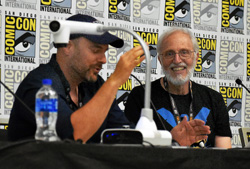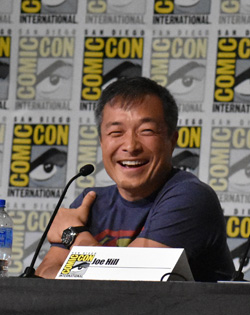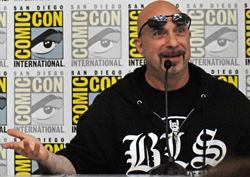By Shor M. Masori

SAN DIEGO — Comic-Con has exploded into a place where pop culture fandoms blend, creating an almost amusement-park atmosphere encompassing everything from the biggest Internet Providers to the smallest fledgling writers and artists. But one thing has remained consistent throughout the convention’s 50 meetings over the last 49 years: the inspiration it gives to the aspiring creator. Amid movies, television, toys, posters, glamour and glitz, the creative comic book community within Comic-Con has stayed small but tight-knit. In it are many hopeful comic book authors and artists, anxious to learn from their idols how they started in the industry, and what tips they might offer about breaking in.

Marv Wolfman reminisced to his fans about going to Jack Kirby’s house as a kid and watching the master craftsman work. He said that Kirby’s wife Roz, doing her duties as a Jewish mother, would make him and Kirby sandwiches before their hours of art began. Kirby, creator of Captain America, was indeed among the best at his craft. Wolfman said that Kirby would first sketch a hand, and then without a reference or draft, a foot. Eventually, each of the shapes would become contiguous and portray exactly what Kirby saw in his mind. Wolfman, who studied to be an art teacher, finally realized he was a better writer than an artist. He stressed to his audience the importance of character and plot. He said character-driven stories can be filled with so much more emotion, an important component of an endearing tale. For those who want to be artists, he said, be prepared to draw about six full pictures per page on 30 pages and fit them together in an appealing way.
Wolfman also touched on the impact of Stan Lee. Before him, comics seemed to be written for a general audience. This made them kid-friendly but unappealing to many teens. “It used to be the same old Lois Lane tries to figure out who ‘Supes’ is,” he said in reference to the Superman series.
Stan Lee thought more of his reader, according to Wolfman. He wrote stories that were filled with drama, psychological thrills, and philosophy. Spider-Man’s first issue was a perfect example. Peter Parker was not an idealized man. When he was given his powers, his immediate instinct was to use them for wealth. It wasn’t until his moral compass, Uncle Ben, died because of his negligence that he became a hero. Parker was made to be a tragic hero. Lee seldom allowed him to have his way. Sure, he would defeat his villains, but he would never achieve true happiness. This brought in vast amounts of readers and inspired many, like Marv Wolfman, to create comics.

Jim Lee, co-Chief Creative Officer of DC comics and an artist celebrating his 33rd conservative year as a panelist at Comic-Con, gets questions similar to this all the time on his Twitch live streams. His response: “Just Draw Dude.” At his Comic-Con panel, He gave some tips on how to sketch. He prefers to draw slightly exaggerated proportions, like bigger hands, because not only are they easier to draw, but they also seem more expressive and eye-catching.
DC artist Greg Capullo shed some light on how he learned to draw so freely and seemingly effortlessly. He wasn’t a good student, so he began learning the craft on his own. He had some natural ability, but after reading art books such as Drawing on the Right Side of the Brain and various anatomy books, he began to hone his craft. He took a year off from work to start focusing on art full time and illustrated everything and anything. He would quickly sketch people on the bus and became familiar with natural looks and gestures.

He finally got his start, and soon enough, Marvel recruited him. The artists at Marvel stressed draftsmanship. After the workers strike in the ’90s, he was asked to work on X-Force, which was one of Marvel’s most significant books. Then Todd McFarlane, who left Marvel during the strike and founded Image Comics with Erik Larsen, Jim Leem, Rob Liefeld, Whilce Portacio, Marc Silvestri, and Jim Valentino asked him to join. After a few months, he accepted the offer. Once at Image Comics, he found that McFarlane was much less concerned with realism in his art. So Capullo began to experiment with basic human shapes and made his characters much more dynamic, but less anatomically correct. Eventually, he started working for DC and continued to evolve as an artist.
Eisner Award-winning writer Tom King said that the easiest way to meet the speedy and hard deadlines at DC is to strip mine stories from his own life, commenting they are better stories than if he were spewing balderdash. Speaking on his past as a novelist, he said, “When you are a novelist, you have a year or two, you write ten books throughout your life. Anyone can find ten stories in their life.” When writing a 20-30 page comic, he has only a week. For his Current Batman series at DC, they put out two comics a month. That in addition to all the smaller limited series that he writes, adds up to quite a hefty workload.
*
Masori is a writer/ photographer for San Diego Jewish World. He may be contacted via shor.masori@sdjewishworld.com